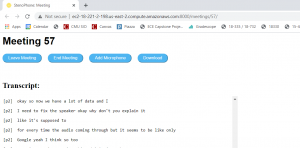We performed our demo last Wednesday and received overall good feedback from Professor Sullivan and Abha. We had some technical difficulties during the beginning of the demo, so we started to add some robustness to the routines. The issue occurred when there were two microphones connected to a meeting and one of the microphones was disconnected. We also worked on testing the AWS deployment as well as formalizing the testing scripts. We also added in the ability to download transcripts of the meeting as pdfs. We have also started working on our final presentation slides.
Since we are performing our tests now, if there are any major issues that require an implementation overhaul, we would have to scramble to accomplish it.
Below is an image of our contraption. It has a Raspberry Pi, microphone, ReSpeaker, and custom ReSpeaker case.

Below is an image of our meeting transcript of our meeting in progress.
